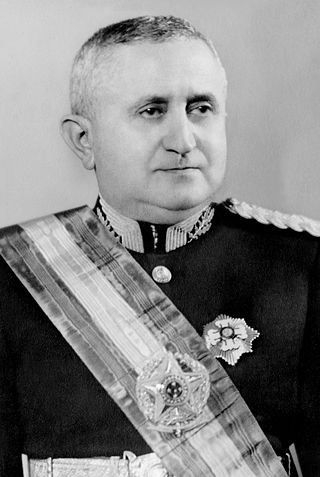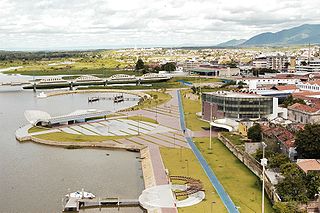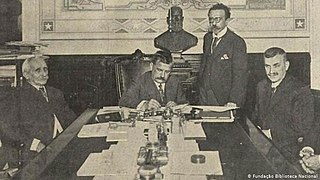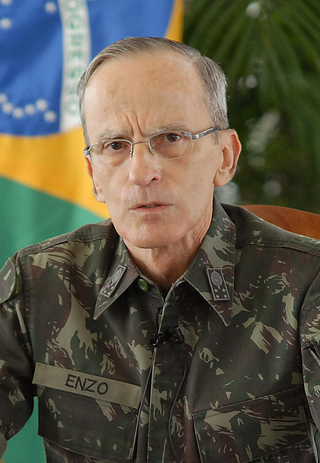
Eurico Gaspar Dutra was a Brazilian military leader and politician who served as the 16th president of Brazil from 1946 to 1951. He was the first President of the Fourth Brazilian Republic, which followed the Vargas Regime.

Tenentism was a political philosophy of junior army officers who significantly contributed to the Brazilian Revolution of 1930 that ended the First Brazilian Republic.

Hermes Rodrigues da Fonseca was a Brazilian field marshal and politician who served as the eighth president of Brazil between 1910 and 1914. He was a nephew of marshal Deodoro da Fonseca, the first president of Brazil, and general João Severiano da Fonseca, patron of the Army Health Service. His parents were the marshal Hermes Ernesto da Fonseca and Rita Rodrigues Barbosa.

The Brazilian Army is the land arm of the Brazilian Armed Forces. The Brazilian Army has fought in several international conflicts, mostly in South America during the 19th century. In the 20th century, it fought on the Allied side in World War I and World War II. Aligned with the Western Bloc during the military dictatorship in Brazil from 1964 to 1985, it also had active participation in Latin America and Southern Portuguese Africa during the Cold War, as well as taking part in UN peacekeeping missions worldwide since the late 1950s.

Sobral is a municipality in the state of Ceará, Brazil.

Military Police are the preventive state police of the states and of the Federal District of Brazil. The Military Police units are the main ostensive police force at the state level and are responsible for policing and maintaining the public order. Their formations, rules and uniforms vary depending on the state. Investigative work and forensics are undertaken by the Civil Police of each state.

João de Deus Mena Barreto was a Brazilian general and politician who briefly served as the president of Brazil while being a member of the provisional military junta of 1930. Born into a historically military family, Mena Barreto took up a military career in 1890. He fought in several internal conflicts, including the Federalist Revolution, a civil war, the 18 of the Copacabana Fort revolt, and a 1924 revolt in the North. With the Revolution of 1930 in Brazil, Mena Barreto and Augusto Tasso Fragoso orchestrated an uprising in the Federal District, overthrowing President Washington Luís and establishing the 1930 junta. After the junta transferred power to revolutionaries, Mena Barreto became the federal interventor for Rio de Janeiro and a mediator in the Constitutionalist Revolution of 1932.

The Confederation of the Equator was a short-lived rebellion that occurred in the northeastern region of the Empire of Brazil in 1824, in the early years of the country's independence from Portugal. The secessionist movement was led by liberals who opposed the authoritarian and centralist policies of the nation's first leader, Emperor Pedro I. The fight occurred in the provinces of Pernambuco, Ceará and Paraíba.

The Copacabana Fort revolt, also known as the 18 of the Fort revolt, was one of several movements coordinated by rebel factions of the Brazilian Army against the president of Brazil, Epitácio Pessoa, and the winner of the 1922 presidential election, Artur Bernardes. Acting under the figure of marshal Hermes da Fonseca and supporting the defeated faction, the Republican Reaction, the rebels tried a wide revolt in Rio de Janeiro on 5 July 1922, but only managed to control Fort Copacabana and the Military School of Realengo, in addition to, outside the city, a focus in Niterói and the 1st Military Circumscription, in Mato Grosso. They were defeated, but the revolt marks the beginning of tenentism and the events that led to the end of the First Brazilian Republic.

The Archdiocese of Fortaleza is an archdiocese located in the city of Fortaleza in Brazil.

During World War I (1914–1918), Brazil initially adopted a neutral position, in accordance with the Hague Convention, in an attempt to maintain markets for its export products, mainly coffee, latex and industrially manufactured items. However, following the repeated sinking of Brazilian merchant ships by German submarines, President Venceslau Brás declared war against the Central Powers in 1917. Brazil was the only country in Latin America to be directly involved in the war. The major participation was the Brazilian Navy's patrol of areas of the Atlantic Ocean.

José Pessoa Cavalcanti de Albuquerque was a military officer, who became a Marshal in the Brazilian Army. Son of Cândido Albuquerque and Maria Albuquerque, he was the nephew of Epitácio Pessoa, and brother of João Pessoa, the Governor of Northern State of Paraiba. He was one of the officers sent on a preparatory mission to Europe by the Brazilian Army during the World War I against the Central Powers. In his subsequent career he had a strong influence on the reform and update of some Brazilian Army branches and institutions. To honor him, the 12th Cavalry Regiment of the Brazilian Army adopted his name.

Enzo Martins Peri is a Brazilian Army general who was the commander of the Brazilian Army from 2007 to 2015.
The following article presents a summary of the 2017 football (soccer) season in Brazil, which was the 116th season of competitive football in the country.

The São Paulo Revolt of 1924 was a Brazilian conflict with characteristics of a civil war, triggered by tenentist rebels to overthrow the government of president Artur Bernardes. Initially started in the city of São Paulo on 5 July, the revolt expanded to the interior of the state and inspired other uprisings. The urban combat ended in a loyalist victory on 28 July. The withdrawal of the rebels, until September, prolonged the rebellion with the Paraná Campaign.

Antônio de Sampaio was a Brazilian brigadier general and war hero, considered to be one of the finest generals during the 19th century. He participated in many rebellions and wars during his service but died from three wounds during the Battle of Tuyutí of the Paraguayan War. He was given the title of Patrono da Arma de Infantaria for his service within the Brazilian infantry.

The Public Forces of the states of Brazil were already called "small states' armies" in the First Brazilian Republic (1889–1930) due to their martial character. They took part in the various struggles and rebellions of the period alongside, and sometimes against, the Brazilian Army. Their character was hybrid, police and warfare. They emerged in the federalism of the First Republic as shields of state power against central power, represented by the Army, and were dismantled by the federal government in the Vargas Era (1930–1945) onwards, losing their conventional warfare capabilities.

The bombing of São Paulo, which took place during the São Paulo Revolt of 1924, was the largest artillery and air attack in São Paulo's history. From 5 to 28 July 1924, rebel and loyalist forces used bombing in their fight for the city; the rebels had up to 26 artillery pieces from the Brazilian Army, while the loyalists accumulated more than a hundred guns and six bombers from the Army Aviation. Artillery, and especially loyalist artillery, was largely responsible for the casualties of the conflict, most of whom were civilians.

Urban combat in the São Paulo Revolt of 1924 was the most violent warfare of its kind in Brazilian history, raging in the city of São Paulo from 5 to 27 July of that year. Rebel tenentist revolutionaries, led by general Isidoro Dias Lopes, intended to take the city in a few hours, but were trapped in combat in the central region against forces loyal to the government of president Artur Bernardes. On 8 July, the loyalists withdrew to the city's outskirts, organizing themselves in general Eduardo Sócrates' "Division of Operations in the State of São Paulo", restarting the fighting in the working-class neighborhoods to the south and east. There was not a complete siege; the rebels had roads open to their territory in the interior, along which they withdrew from the city on the night of 27 July and continued their rebellion.

During Brazil's First Republic (1889–1930), the Brazilian Army was one of several land-based military forces present in the country. The army was equipped and funded by the federal government, while state and local chiefs had the Public Forces and irregular forces such as patriotic battalions.


















